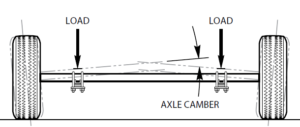The browser you are using is not supported. Please consider using a modern browser.
Trailer Maintenace
What is camber on a boat trailer?
On a boat trailer, camber refers to the tilt of the wheels relative to vertical when viewed from the front or rear. A slight camber angle is designed into the axle so that, under load, the wheels align properly with the road surface.
Proper camber is important because it affects:
Tire Contact: Ensures the tread meets the road evenly.
Tire Wear: Reduces uneven or premature wear.
Stability: Helps the trailer track straight and handle predictably.

Camber Angle
Camber is measured in degrees and can be either:
- Positive Camber: The tops of the wheels tilt outward. Most trailer axles are manufactured with slight positive camber when unloaded. As weight is added, the axle flexes, bringing the wheels back to vertical.
- Negative Camber: The tops of the wheels tilt inward. This is unusual for trailers and often indicates axle bending, overloading, or damage.
- Neutral (Zero) Camber: Wheels are perfectly vertical, which is the goal once the trailer is loaded.
Purpose of Camber
The primary purpose of camber is to ensure the tire tread sits flat on the road when the trailer is loaded. Proper camber:
- Distributes weight evenly across the tire’s contact patch
- Improves traction and tracking
- Reduces uneven tire wear
Adjustment and Maintenance
- Over time, camber can change due to axle fatigue, overloading, or impact damage.
- Camber is not typically adjustable on trailer axles; if it is out of spec, the axle may need repair or replacement.
- Inspect camber during regular trailer service—especially if you notice uneven tire wear or poor tracking.
Effects of Incorrect Camber
If camber is outside manufacturer specifications, it can cause:
- Excessive Positive Camber: Inner edges of tires wear prematurely.
- Excessive Negative Camber: Outer edges of tires wear prematurely.
- Both Conditions: Poor tracking, reduced stability, and shortened tire life.
Regular inspection of camber helps extend tire life and ensures safe towing.
How do you inspect camber on a boat trailer?
Inspecting camber is straightforward and can often be done visually with a few simple tools:
1. Park on Level Ground
- Place the trailer on a flat, level surface with the boat loaded as it would be for towing.
2. Stand in Front or Behind the Trailer
- Look at the wheels from the front or rear.
- The tires should appear nearly vertical. A very slight outward tilt at the top (positive camber) is normal when unloaded.
3.Use a Carpenter’s Square or Level (Optional)
- Hold a long carpenter’s square or bubble level vertically against the tire sidewall.
- Compare the wheel’s angle to true vertical.
4.Check for Tire Wear Patterns
- Uneven wear on the inside or outside tread often indicates incorrect camber.
5.Confirm With Professional Alignment Tools (if needed)
- For precise measurement, a trailer shop can measure camber in degrees.
⚠️ When to Take Action
- If wheels appear tilted more than slightly, or if tires show uneven wear, have the axle inspected.
- Since trailer camber isn’t adjustable, a bent or fatigued axle may require replacement.